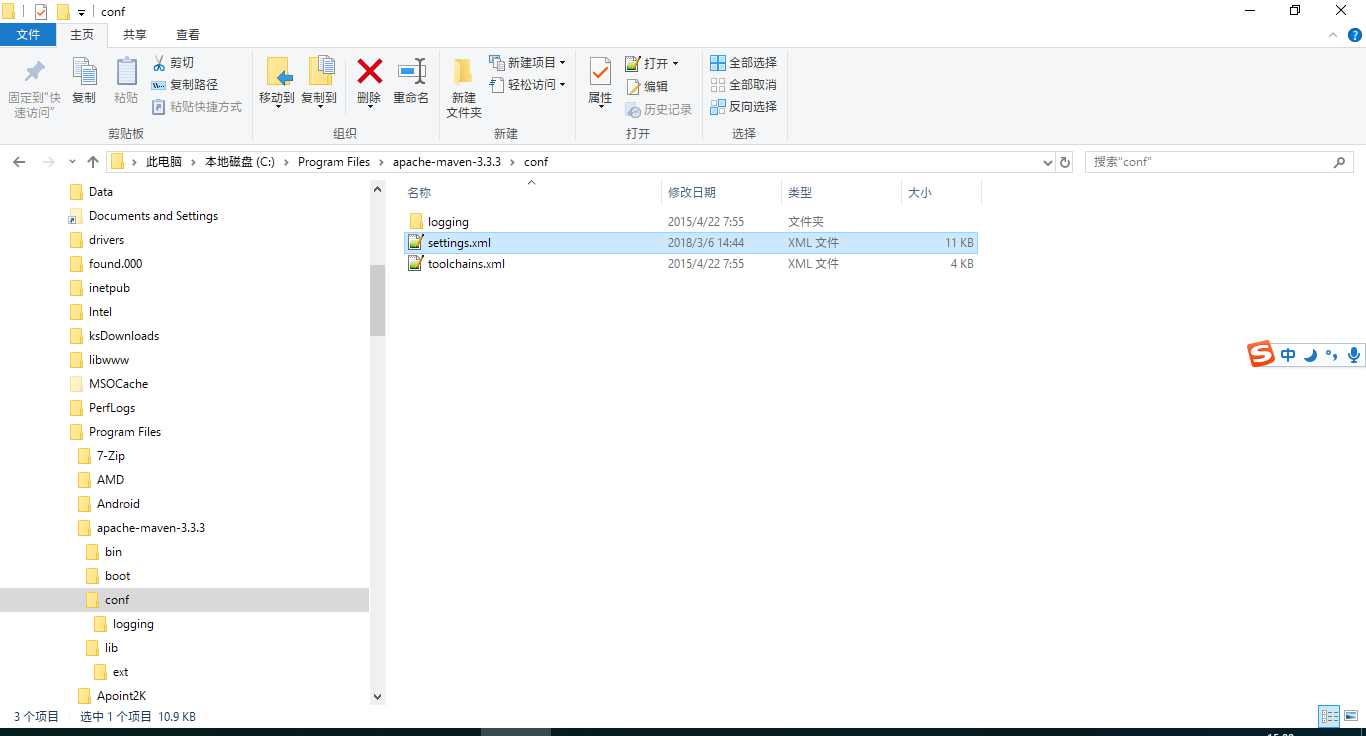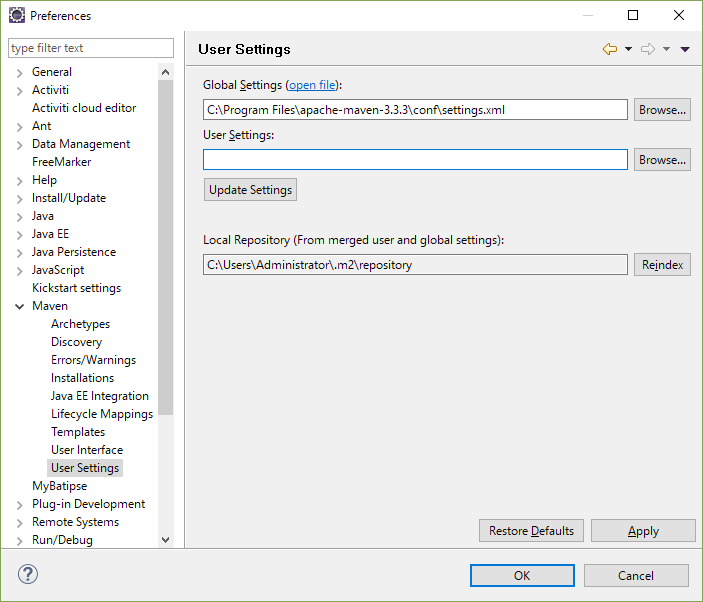Maven 3.3全局配置
Maven采用全局配置的方案:



- <?xml version="1.0" encoding="UTF-8"?>
- <!--
- Licensed to the Apache Software Foundation (ASF) under one
- or more contributor license agreements. See the NOTICE file
- distributed with this work for additional information
- regarding copyright ownership. The ASF licenses this file
- to you under the Apache License, Version 2.0 (the
- "License"); you may not use this file except in compliance
- with the License. You may obtain a copy of the License at
- http://www.apache.org/licenses/LICENSE-2.0
- Unless required by applicable law or agreed to in writing,
- software distributed under the License is distributed on an
- "AS IS" BASIS, WITHOUT WARRANTIES OR CONDITIONS OF ANY
- KIND, either express or implied. See the License for the
- specific language governing permissions and limitations
- under the License.
- -->
- <!--
- | This is the configuration file for Maven. It can be specified at two levels:
- |
- | 1. User Level. This settings.xml file provides configuration for a single user,
- | and is normally provided in ${user.home}/.m2/settings.xml.
- |
- | NOTE: This location can be overridden with the CLI option:
- |
- | -s /path/to/user/settings.xml
- |
- | 2. Global Level. This settings.xml file provides configuration for all Maven
- | users on a machine (assuming they're all using the same Maven
- | installation). It's normally provided in
- | ${maven.home}/conf/settings.xml.
- |
- | NOTE: This location can be overridden with the CLI option:
- |
- | -gs /path/to/global/settings.xml
- |
- | The sections in this sample file are intended to give you a running start at
- | getting the most out of your Maven installation. Where appropriate, the default
- | values (values used when the setting is not specified) are provided.
- |
- |-->
- <settings xmlns="http://maven.apache.org/SETTINGS/1.0.0"
- xmlns:xsi="http://www.w3.org/2001/XMLSchema-instance"
- xsi:schemaLocation="http://maven.apache.org/SETTINGS/1.0.0 http://maven.apache.org/xsd/settings-1.0.0.xsd">
- <!-- localRepository
- | The path to the local repository maven will use to store artifacts.
- |
- | Default: ${user.home}/.m2/repository-->
- <localRepository>C:\Users\Administrator\.m2\repository</localRepository>
- <!-- interactiveMode
- | This will determine whether maven prompts you when it needs input. If set to false,
- | maven will use a sensible default value, perhaps based on some other setting, for
- | the parameter in question.
- |
- | Default: true
- <interactiveMode>true</interactiveMode>
- -->
- <!-- offline
- | Determines whether maven should attempt to connect to the network when executing a build.
- | This will have an effect on artifact downloads, artifact deployment, and others.
- |
- | Default: false
- <offline>false</offline>
- -->
- <!-- pluginGroups
- | This is a list of additional group identifiers that will be searched when resolving plugins by their prefix, i.e.
- | when invoking a command line like "mvn prefix:goal". Maven will automatically add the group identifiers
- | "org.apache.maven.plugins" and "org.codehaus.mojo" if these are not already contained in the list.
- |-->
- <pluginGroups>
- <!-- pluginGroup
- | Specifies a further group identifier to use for plugin lookup.
- <pluginGroup>com.your.plugins</pluginGroup>
- -->
- </pluginGroups>
- <!-- proxies
- | This is a list of proxies which can be used on this machine to connect to the network.
- | Unless otherwise specified (by system property or command-line switch), the first proxy
- | specification in this list marked as active will be used.
- |-->
- <proxies>
- <!-- proxy
- | Specification for one proxy, to be used in connecting to the network.
- |
- <proxy>
- <id>optional</id>
- <active>true</active>
- <protocol>http</protocol>
- <username>proxyuser</username>
- <password>proxypass</password>
- <host>proxy.host.net</host>
- <port>80</port>
- <nonProxyHosts>local.net|some.host.com</nonProxyHosts>
- </proxy>
- -->
- </proxies>
- <!-- servers
- | This is a list of authentication profiles, keyed by the server-id used within the system.
- | Authentication profiles can be used whenever maven must make a connection to a remote server.
- |-->
- <servers>
- <!-- server
- | Specifies the authentication information to use when connecting to a particular server, identified by
- | a unique name within the system (referred to by the 'id' attribute below).
- |
- | NOTE: You should either specify username/password OR privateKey/passphrase, since these pairings are
- | used together.
- |
- <server>
- <id>deploymentRepo</id>
- <username>repouser</username>
- <password>repopwd</password>
- </server>
- -->
- <!-- Another sample, using keys to authenticate.-->
- <server>
- <id>nexus-releases</id>
- <username>admin</username>
- <password>admin123</password>
- </server>
- <server>
- <id>nexus-snapshots</id>
- <username>admin</username>
- <password>admin123</password>
- </server>
- </servers>
- <!-- mirrors
- | This is a list of mirrors to be used in downloading artifacts from remote repositories.
- |
- | It works like this: a POM may declare a repository to use in resolving certain artifacts.
- | However, this repository may have problems with heavy traffic at times, so people have mirrored
- | it to several places.
- |
- | That repository definition will have a unique id, so we can create a mirror reference for that
- | repository, to be used as an alternate download site. The mirror site will be the preferred
- | server for that repository.
- |-->
- <mirrors>
- <!-- mirror
- | Specifies a repository mirror site to use instead of a given repository. The repository that
- | this mirror serves has an ID that matches the mirrorOf element of this mirror. IDs are used
- | for inheritance and direct lookup purposes, and must be unique across the set of mirrors.
- | -->
- <mirror>
- <id>offical</id>
- <name>Maven Official Repository</name>
- <url>http://repo1.maven.org/maven2</url>
- <mirrorOf>central</mirrorOf>
- </mirror>
- <mirror>
- <id>jboss</id>
- <name>Jboss Repository</name>
- <url>http://repository.jboss.org/nexus/content/groups/public-jboss/</url>
- <mirrorOf>central</mirrorOf>
- </mirror>
- <mirror>
- <id>AsposeJavaAPI</id>
- <name>Aspose Java API</name>
- <url>http://maven.aspose.com/repository/repo</url>
- <mirrorOf>*</mirrorOf>
- </mirror>
- <mirror>
- <id>mvn</id>
- <name>Mvn Repository</name>
- <url>https://mvnrepository.com/</url>
- <mirrorOf>central</mirrorOf>
- </mirror>
- </mirrors>
- <!-- profiles
- | This is a list of profiles which can be activated in a variety of ways, and which can modify
- | the build process. Profiles provided in the settings.xml are intended to provide local machine-
- | specific paths and repository locations which allow the build to work in the local environment.
- |
- | For example, if you have an integration testing plugin - like cactus - that needs to know where
- | your Tomcat instance is installed, you can provide a variable here such that the variable is
- | dereferenced during the build process to configure the cactus plugin.
- |
- | As noted above, profiles can be activated in a variety of ways. One way - the activeProfiles
- | section of this document (settings.xml) - will be discussed later. Another way essentially
- | relies on the detection of a system property, either matching a particular value for the property,
- | or merely testing its existence. Profiles can also be activated by JDK version prefix, where a
- | value of '1.4' might activate a profile when the build is executed on a JDK version of '1.4.2_07'.
- | Finally, the list of active profiles can be specified directly from the command line.
- |
- | NOTE: For profiles defined in the settings.xml, you are restricted to specifying only artifact
- | repositories, plugin repositories, and free-form properties to be used as configuration
- | variables for plugins in the POM.
- |
- |-->
- <profiles>
- <!-- profile
- | Specifies a set of introductions to the build process, to be activated using one or more of the
- | mechanisms described above. For inheritance purposes, and to activate profiles via <activatedProfiles/>
- | or the command line, profiles have to have an ID that is unique.
- |
- | An encouraged best practice for profile identification is to use a consistent naming convention
- | for profiles, such as 'env-dev', 'env-test', 'env-production', 'user-jdcasey', 'user-brett', etc.
- | This will make it more intuitive to understand what the set of introduced profiles is attempting
- | to accomplish, particularly when you only have a list of profile id's for debug.
- |
- | This profile example uses the JDK version to trigger activation, and provides a JDK-specific repo.
- <profile>
- <id>jdk-1.4</id>
- <activation>
- <jdk>1.4</jdk>
- </activation>
- <repositories>
- <repository>
- <id>jdk14</id>
- <name>Repository for JDK 1.4 builds</name>
- <url>http://www.myhost.com/maven/jdk14</url>
- <layout>default</layout>
- <snapshotPolicy>always</snapshotPolicy>
- </repository>
- </repositories>
- </profile>
- -->
- <!--
- | Here is another profile, activated by the system property 'target-env' with a value of 'dev',
- | which provides a specific path to the Tomcat instance. To use this, your plugin configuration
- | might hypothetically look like:
- |
- | ...
- | <plugin>
- | <groupId>org.myco.myplugins</groupId>
- | <artifactId>myplugin</artifactId>
- |
- | <configuration>
- | <tomcatLocation>${tomcatPath}</tomcatLocation>
- | </configuration>
- | </plugin>
- | ...
- |
- | NOTE: If you just wanted to inject this configuration whenever someone set 'target-env' to
- | anything, you could just leave off the <value/> inside the activation-property.
- |
- <profile>
- <id>env-dev</id>
- <activation>
- <property>
- <name>target-env</name>
- <value>dev</value>
- </property>
- </activation>
- <properties>
- <tomcatPath>/path/to/tomcat/instance</tomcatPath>
- </properties>
- </profile>
- -->
- <profile>
- <id>dev</id>
- <repositories>
- <repository>
- <id>local-nexus</id>
- <url>http://192.168.110.225:8081/nexus/content/groups/public</url>
- <releases>
- <enabled>true</enabled>
- </releases>
- <snapshots>
- <enabled>true</enabled>
- </snapshots>
- </repository>
- </repositories>
- </profile>
- <!-- Ƥ׃Ѿ֘Ӗࠢ -->
- </profiles>
- <!-- ǴԃѾ֘Ӗࠢ -->
- <activeProfiles>
- <activeProfile>dev</activeProfile>
- </activeProfiles>
- <!-- activeProfiles
- | List of profiles that are active for all builds.
- |
- <activeProfiles>
- <activeProfile>alwaysActiveProfile</activeProfile>
- <activeProfile>anotherAlwaysActiveProfile</activeProfile>
- </activeProfiles>
- -->
- </settings>
Maven 3.3全局配置的更多相关文章
- Maven使用(一)—— Maven的安装与全局配置
一.Maven安装 Maven的安装步骤: 1.Maven官网(http://maven.apache.org/)下载压缩包,解压缩,当前最新版本是apache-maven-3.5.3-bin.zip ...
- maven工程指定jdk版本,maven全局配置jdk的版本
- IDEA修改Maven全局配置
在使用过程中发现,IDEA每次新建一个Project ,这个maven配置都会初始化默认的. 这里需要设置下全局配置: File -> Other Settings -> Settings ...
- Maven的安装、配置及使用入门
Maven的安装.配置及使用入门 本书代码下载 大家可以从我的网站下载本书的代码:http://www.juvenxu.com/mvn-in-action/,也可以通过我的网站与我取得联系,欢迎大家与 ...
- 1.Maven的安装及配置
1 Maven 介绍 Maven这个词可以翻译为“知识的积累”,也可以翻译为“专家”或“内行”.本书将介绍Maven这一跨平台的项目管理工具.作为Apache组织中的一个颇为成功的开源项目,Maven ...
- Apache Maven 3.6.1配置安装
Apache Maven 3.6.1配置安装 一.下载 maven下载地址:http://maven.apache.org/download.cgi 二.安装 1,解压即可用 2,环境变量配置 MAV ...
- 架构(二)Maven安装以及Nexus配置
一 Maven安装配置 1.1 下载 http://mirrors.tuna.tsinghua.edu.cn/apache/maven/maven-3/3.5.4/binaries/apache-ma ...
- Jenkins Jenkins结合GIT Maven持续集成环境配置
Jenkins结合GIT Maven持续集成环境配置 by:授客 QQ:1033553122 安装Git插件 1 安装Git客户端 1 安装JAVA JDK及MAVEN 2 Jenkins JDK ...
- Java开发环境配置(4)--Maven安装 环境变量配置,本地仓库配置---插件安装
说明在前:本人用过的 luna mars 等,都已经自带maven插件的了,以下有些文章是很老的,讲到maven插件的安装都可以忽略掉. maven安装eclipse在线配置maven搞定所有插件_ ...
随机推荐
- 2018-2019-2 《网络对抗技术》Exp0 Kali安装 Week1 20165318
2018-2019-2 <网络对抗技术>Exp0 Kali安装 Week1 20165318 下载地址 Kali官网,选择Kali Linux 64 bit VMware 安装步骤 以下步 ...
- RESTful API实战笔记(接口设计及Java后端实现)
写在前面的话 原计划这部分代码的更新也是上传到ssm-demo仓库中,因为如下原因并没有这么做: 有些使用了该项目的朋友建议重新创建一个仓库,因为原来仓库中的项目太多,结构多少有些乱糟糟的. 而且这次 ...
- 1092 回文字符串(LCSL_DP)
1092 回文字符串 基准时间限制:1 秒 空间限制:131072 KB 分值: 10 难度:2级算法题 收藏 关注 回文串是指aba.abba.cccbccc.aaaa这种左右对称的字符串.每个字符 ...
- 如何在Windows平台下安装配置Memcached
Memcached是一个自由开源的,高性能,分布式内存对象缓存系统. Memcached是以LiveJournal旗下Danga Interactive公司的Brad Fitzpatric为首开发的一 ...
- 怎样使用CSS3媒体查询(Media Queries)制作响应式网站
自本周开始博主将开始同大家一起研究响应式web设计,CSS3 Media Queries是入门,本周更新,博主将给大家分享media queries的一些常用的用法及注意事项. Media Queri ...
- <数据结构与算法分析>读书笔记--最大子序列和问题的求解
现在我们将要叙述四个算法来求解早先提出的最大子序列和问题. 第一个算法,它只是穷举式地尝试所有的可能.for循环中的循环变量反映了Java中数组从0开始而不是从1开始这样一个事实.还有,本算法并不计算 ...
- PAT A1126 Eulerian Path (25 分)——连通图,入度
In graph theory, an Eulerian path is a path in a graph which visits every edge exactly once. Similar ...
- Linux 安装erlang
安装rabbitmq的基础erlang1. 下载erlang 版本:otp_src_20.1.tar.gz 地址: http://erlang.org/download/?M=D 2.安装erlang ...
- 二、java三大特性--继承
在讲解之前我们先看一个例子 Husband.java public class Husband { private String name; private String sex; privatein ...
- Vue-Vue列表渲染v-for
v-for 指令需要以 site in sites 形式的特殊语法 一.v-for 循环数组 HTML代码 <div id="app"> <ul> < ...
